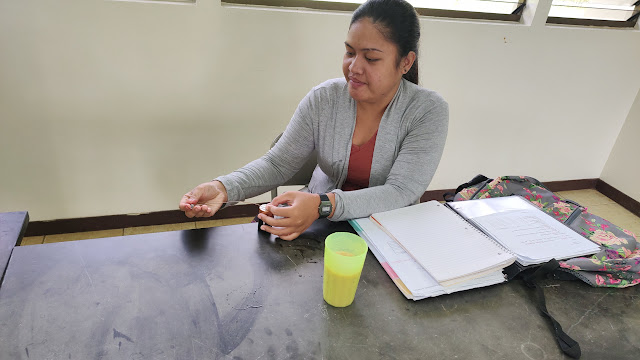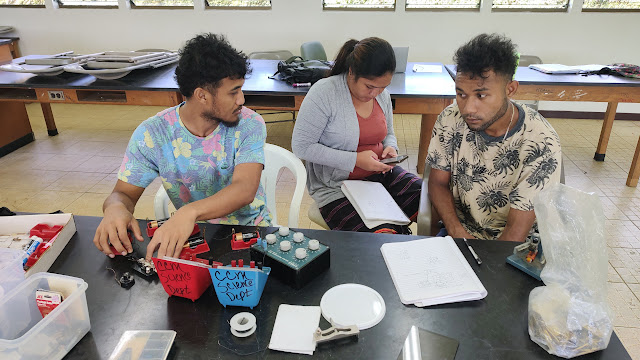I used the kettle to calculate the cost per hour to have the 1500 W kettle running. This was a slightly different approach than I have taken in the past. I first calculated the cost per hour: 1.5 kilowatts times $0.56 per hour. I used the rate prior to the government subsidy.
As usual I wrapped up with the cost for the split air conditioning units.
Again, I worked out the cost per hour and then moved up to per day, per week, per year, and then for all 12 units on the building. Which leads eventually to showing that air conditioning is a leading power cost for the college.
Athina Viola
On Thursday the approach of putting the bulb at the far end of the single wire stretched out was a common approach at 8:00. Few students had engaged in batteries and bulbs.
Jonathan also trying to connect the bulb to the tip end of a single wire
K'con, on the other side of the room trying the same arrangement
Sharla also trying this arrangement. Circuits are not an obvious concept.
Serjeann, same arrangement
Ashlen trying a purely vertical orientation

Serjeann
The arrangement can be seen here more clearly
Ashlen teams up with Serjeann
Ashlen, Sharla, and Serjeann working together to use more batteries and wires
The use of three batteries and two wires would lead to lighting the bulb
In the above photo the three were wrestling with keeping the batteries in contact and the wires touching the batteries: they understood that connectivity was necessary. They had not yet fully understood what comprises a closed circuit. They were trying to touch both wires to the sides of the bulb, but they missed and hit the nib, briefly lighting the bulb. They did this a couple more times and then realized that the nib end had to contact one of the two wires.
Now they had a bulb that lit up
Mersayes and Ashlen make Ohm's law readings
Jonathan reads out values to Athina Viola while Jarret watches
The left board remained intact from Wednesday, a real plus this term.
The right board at the end of the 8:00 section.
A detail view from the right board.
Data tables from 8:00
Milain and Fiji work on lighting a bulb
Billie, Fiji, and Ozimy
Milai records values at three battteries, Jenna assists
Fiji rerigs to add batteries
Milain set up another battery
Jenna reads values while Milain records
Polly Melina and Billy work on a self-started project to light six bulbs at once in a parallel circuit
Milain calls for more batteries
Jenna checks the circuit for current
Six bulbs lit in a parallel circuit using three batteries
Right board at the end of the 11:00 section.
The plan for Friday is to beef up coverage of the history of electricity with Shock and Awe: The Story of Electricity. I think science makes more sense when the contexts in which the science developed are known. There is a lot of tradition in science: the letters used for specific variables, the direction current is taken to be flowing, the choice of terminology and the associated conceptualizations. There is a tendency to present the students with science as a fait accompli, all wrapped up with a nice bow. One day someone woke up and wrote down the correct answer from the get go. That is not what happened, and presenting science as "the facts and just the facts" does a disservice to how science reaches a consensus, how truth emerges in a scientific field. The result is a shallow understanding of science as an emergent truth. There is the collateral damage that when modern science reverses a prior position, non-scientists see science as a matter of opinion, of fashion, subject to unpredictably reversal. If science is truth, shouldn't it always be true? And that is not how science works. History tells the tell of dead ends, of incorrect theories and ideas. Of Newton's particles of light. Or the ether that carried waves of light. Or current as positive charges flowing from the positive to the negative.







































Comments
Post a Comment